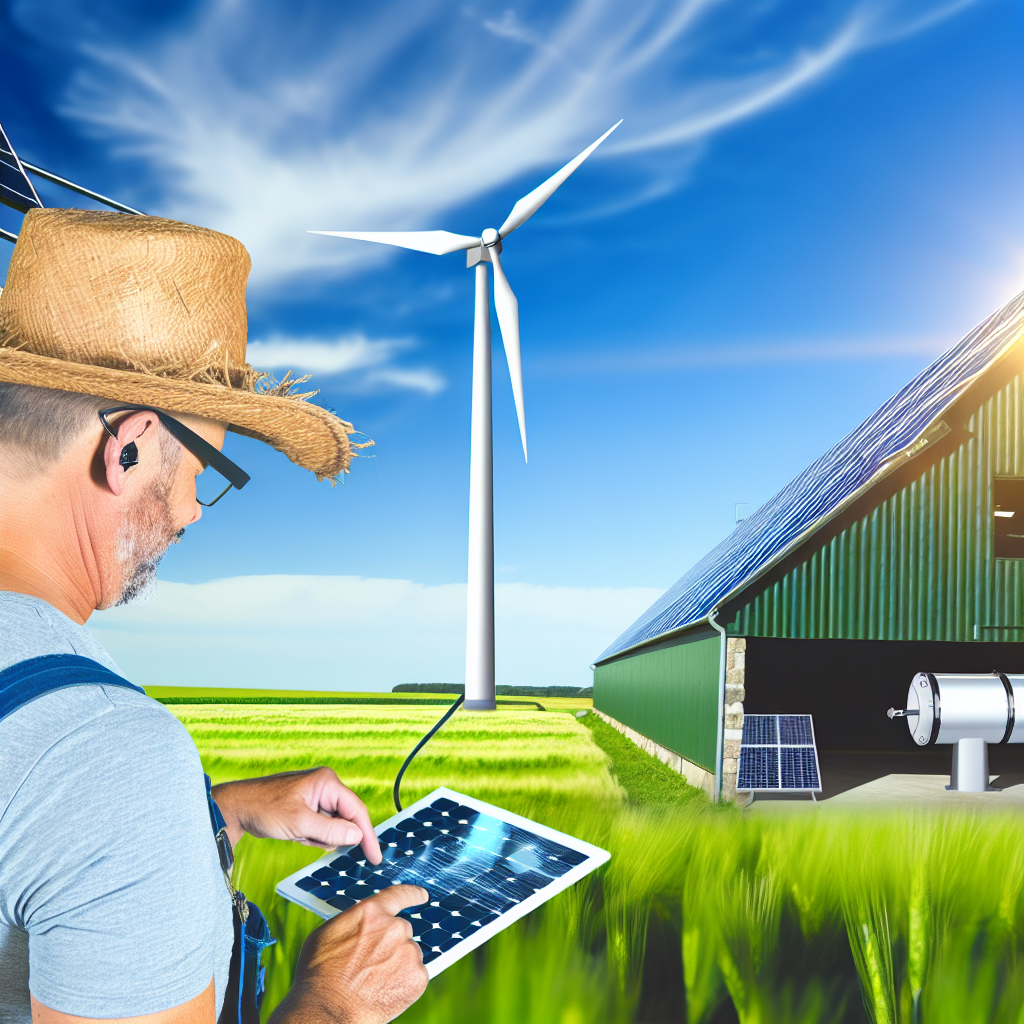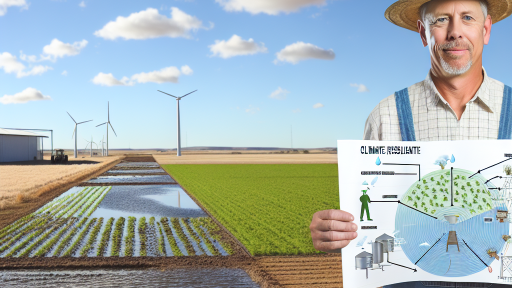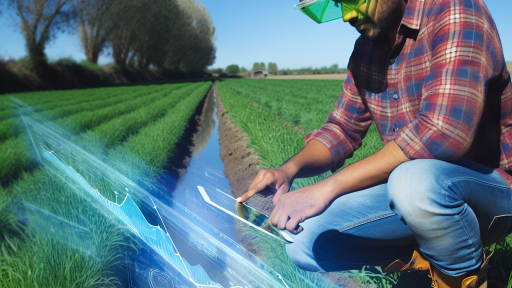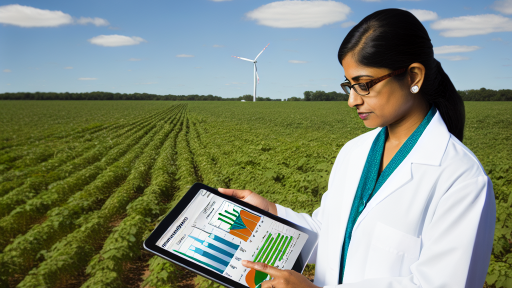Introduction to Renewable Energy in Agriculture
Importance of Sustainability
Sustainable farming practices are crucial for our environment.
They help reduce the negative effects of climate change.
By using renewable energy, farmers can lower their carbon footprint.
Solar and wind technologies provide cleaner energy sources.
These technologies support the efficient use of land and resources.
Adopting renewable energy also leads to cost savings in the long run.
For instance, solar panels can significantly reduce electricity bills.
Moreover, wind turbines harness natural wind currents to generate power.
As a result, farmers gain more autonomy over their energy supply.
This independence enhances their resilience against energy price fluctuations.
Transitioning to sustainable practices meets consumer demand.
Many consumers prefer eco-friendly products and practices.
Additionally, government incentives encourage renewable energy adoption.
Investing in these technologies can improve farm efficiency.
Ultimately, sustainable farming supports global food security.
Transform Your Agribusiness
Unlock your farm's potential with expert advice tailored to your needs. Get actionable steps that drive real results.
Get StartedIt ensures healthy ecosystems for future generations.
Integrating solar and wind technologies is vital.
Farmers can safeguard their livelihoods through responsible practices.
Overview of Solar Energy Technologies Applied in Farming
Introduction to Solar Energy in Agriculture
Solar energy technologies play a vital role in modern farming.
They provide sustainable solutions for energy needs.
Farmers increasingly rely on solar power systems.
These systems help reduce operational costs.
Furthermore, they enhance farm resilience against energy price fluctuations.
Types of Solar Technologies Used in Farming
Several solar technologies are applicable to agricultural practices.
- Photovoltaic (PV) systems convert sunlight into electricity.
- Solar thermal systems capture heat for water heating.
- Concentrated solar power (CSP) systems use mirrors to focus sunlight.
Benefits of Implementing Solar Technologies
Employing solar technologies offers numerous advantages.
- Solar energy significantly lowers carbon footprints.
- These technologies enhance energy security for farmers.
- They may increase farm profitability through energy savings.
Real-World Applications of Solar in Farming
Solar technologies find diverse applications in agriculture.
Farmers use PV systems for powering irrigation pumps.
Additionally, greenhouses often utilize solar thermal systems for heating.
This approach optimizes growing conditions and reduces fossil fuel dependency.
Challenges and Considerations
Though solar technologies are beneficial, challenges exist.
Initial installation costs can be significant for farmers.
Additionally, consistent sunlight availability may vary by location.
Farmers must also consider necessary maintenance for solar systems.
Innovations and Future Trends in Solar Farming
Emerging innovations are enhancing solar energy use in agriculture.
Farmers explore agrivoltaics, where agricultural land supports solar panels.
This method promotes dual land use while maximizing productivity.
Technological advancements continue to decrease costs and increase efficiency.
Types of Wind Energy Technologies Favorable for Agricultural Use
Horizontal Axis Wind Turbines
Horizontal axis wind turbines (HAWTs) dominate the wind energy landscape.
These turbines feature blades that rotate around a horizontal axis.
Showcase Your Farming Business
Publish your professional farming services profile on our blog for a one-time fee of $200 and reach a dedicated audience of farmers and agribusiness owners.
Publish Your ProfileFarmers widely adopt HAWTs due to their efficiency and reliability.
They can generate substantial electricity, even in moderate wind conditions.
Moreover, HAWTs offer scalability, which makes them suitable for various farm sizes.
Vertical Axis Wind Turbines
Vertical axis wind turbines (VAWTs) present an alternative design.
VAWTs have blades that rotate around a vertical axis.
They perform well in turbulent wind conditions that often occur on farms.
These turbines require less maintenance due to their lower center of gravity.
Consequently, farmers can use them in locations with space constraints.
Small Wind Turbines
Small wind turbines are ideal for individual farms.
They typically generate between 400 watts and 100 kilowatts.
Farmers can install these turbines to power specific farm operations.
Examples include irrigation systems and livestock facilities.
Additionally, they can help reduce energy costs significantly.
Hybrid Systems
Hybrid systems combine wind and solar technologies.
This integration maximizes energy production throughout the year.
Farmers can effectively harness both wind and solar resources.
Hybrid systems offer versatile solutions for diverse farming needs.
They can contribute to energy resilience and sustainability.
Off-Grid Applications
Wind technology significantly supports off-grid farming projects.
Farmers in remote areas can benefit from reliable energy sources.
Off-grid wind systems provide power for operations away from utilities.
This energy independence enhances operational efficiency on farms.
Moreover, it reduces dependence on fossil fuels, promoting sustainability.
You Might Also Like: Using Technology to Optimize Water Use on Farms
Integration of Solar Systems in Farm Operations: Case Studies
Solar Energy Adoption in Agriculture
Farmers increasingly turn to solar energy for operational efficiency.
This transition significantly reduces reliance on fossil fuels.
Moreover, it results in long-term cost savings for agricultural businesses.
An example is Green Fields Farm in California; they installed solar panels on their barn roofs.
As a result, they achieved energy independence and decreased utility bills.
Consequently, they directed those funds toward increasing crop production.
Implementation of Solar Water Pumps
Solar water pumps represent another innovative application on farms.
These systems provide a cost-effective alternative to electric or diesel pumps.
At Desert Bloom Farms, solar water pumps facilitate irrigation efficiently.
This method supports sustainable water use in arid regions.
As a result, the farm boasts healthier crops and improved yields.
Case Study: Wind Turbines in Crop Production
Some farms also implement wind energy solutions for sustainability.
Skyward Acres, located in Nebraska, installed small wind turbines for energy production.
This initiative eliminates greenhouse gas emissions associated with traditional power sources.
Furthermore, it supplies energy for operating machinery and lighting needs.
Combining Solar and Wind Energy
Many farms benefit from a combination of solar and wind technologies.
Showcase Your Farming Business
Publish your professional farming services profile on our blog for a one-time fee of $200 and reach a dedicated audience of farmers and agribusiness owners.
Publish Your ProfileA prime example is AgriTech Farms in Texas, integrating both systems.
The synergy between solar panels and wind turbines maximizes energy output.
This approach provides a reliable energy source year-round, even during cloudy or low-wind days.
Challenges and Solutions
Despite the benefits, farmers face challenges in integrating renewable energy.
High upfront costs can deter initial investments; however, incentives exist to ease this burden.
For instance, tax credits and grants help farmers offset installation expenses.
Moreover, educational programs promote awareness about the advantages of renewable energy.
The Future of Energy in Agriculture
As technology advances, energy systems continue to evolve in agriculture.
Innovative farming practices are crucial for sustainable growth.
Furthermore, the adoption of renewable energy is vital for future food security.
By embracing these technologies, farmers can enhance productivity and sustainability.
Find Out More: Carbon Footprint Reduction Methods for Farmers
Utilization of Wind Turbines for Energy Needs on Farms
Introduction to Wind Energy
Wind energy offers a sustainable solution for powering farms.
It harnesses natural wind flow to generate electricity.
This method significantly reduces reliance on fossil fuels.
Farmers can lower operational costs while promoting environmental health.
Advantages of Wind Turbines on Farms
Wind turbines provide a variety of benefits for agricultural operations.
One major advantage is energy independence.
Farmers can generate their own power rather than purchasing it.
Moreover, these turbines can decrease energy costs over time.
Additionally, excess energy can be sold back to the grid.
Choosing the Right Wind Turbine
Selecting an appropriate turbine is critical for success.
Farmers should consider the turbine’s size and capacity.
Moreover, local wind patterns influence turbine efficiency.
Installation costs and potential return on investment are also vital factors.
Integrating Wind Energy with Other Technologies
Combining wind energy with solar technologies enhances sustainability.
Farmers can create hybrid systems for more consistent energy supply.
This integration optimizes land use and improves electricity generation.
Case Studies of Successful Implementation
Many farms have successfully integrated wind turbines.
For instance, Green Valley Farms reduced energy costs by 40%.
They reported a significant increase in energy efficiency.
Similarly, Maple Leaf Orchards utilizes surplus energy for irrigation.
Future Directions in Wind Energy for Farming
The future of wind energy on farms is promising.
Advancements in turbine technology will enhance efficiency.
Supportive policies will encourage more farmers to invest.
Ultimately, this shift will promote sustainable agricultural practices.
Gain More Insights: Advanced Mulching Techniques to Preserve Soil Moisture

Economic Benefits of Adopting Solar and Wind Technologies in Agriculture
Cost Savings on Energy
Solar and wind technologies significantly reduce energy costs for farmers.
Farmers can generate their own electricity, decreasing reliance on external sources.
This independence leads to long-term savings on energy bills.
Showcase Your Farming Business
Publish your professional farming services profile on our blog for a one-time fee of $200 and reach a dedicated audience of farmers and agribusiness owners.
Publish Your ProfileAdditionally, lower energy costs can increase profit margins for agricultural businesses.
Access to Incentives and Subsidies
Government programs often provide incentives for renewable energy installations.
Farmers can access grants, rebates, and tax credits for solar and wind investments.
These financial aids reduce the initial investment burden on farmers.
Consequently, more farmers are likely to adopt these technologies.
Increased Property Value
Investing in renewable energy solutions can enhance property value.
Properties equipped with solar panels or wind turbines are in high demand.
They appeal to buyers seeking sustainable living solutions.
Thus, adopting these technologies proves beneficial when selling the property.
Enhanced Resilience Against Market Fluctuations
Renewable energy sources provide farmers with energy price stability.
With lower energy costs, farmers can better buffer against market fluctuations.
This financial stability offers peace of mind for agricultural planning.
Consequently, farmers can focus on improving productivity and profitability.
Improved Environmental Image
Utilizing solar and wind technologies enhances the farmer’s environmental image.
Many consumers prefer products from environmentally responsible producers.
Building a sustainable farm reputation can attract eco-conscious customers.
Moreover, a good public image often leads to increased sales opportunities.
Long-term Investment in Sustainability
Investing in renewable energy is a commitment to sustainability.
These technologies contribute to a reduction in greenhouse gas emissions.
In turn, they promote a healthier ecosystem for future generations.
Farmers play a crucial role in fostering a sustainable agricultural landscape.
Find Out More: Implementing Cover Crops to Enhance Water Retention
Challenges and Limitations of Implementing Solar and Wind Technologies in Farming
High Initial Costs
One major challenge is the high initial investment for solar and wind technology.
Farmers often face significant upfront expenses for purchasing and installing these systems.
Financial barriers can deter smaller operations from adopting clean energy solutions.
Moreover, obtaining financing for such projects can be complicated.
Consequently, many farmers remain hesitant despite the long-term savings.
Land and Space Constraints
Using solar panels and wind turbines requires ample land space.
This necessity can conflict with agricultural land needed for growing crops.
Farmers must carefully assess their land use to accommodate energy generation.
In urban or densely populated regions, space becomes a critical limiting factor.
Additionally, integrating these technologies into existing infrastructure poses challenges.
Intermittent Energy Generation
Solar and wind energy production is not constant.
Weather conditions significantly influence energy output from these systems.
This intermittency can lead to inconsistencies in energy availability.
Consequently, farmers may require backup systems for reliable energy access.
Investing in energy storage solutions can significantly increase overall costs.
Maintenance and Technical Expertise
Maintenance of solar panels and wind turbines requires specific technical skills.
Farmers may lack the technical expertise needed to maintain these systems efficiently.
Additionally, hiring external professionals can lead to increased operational costs.
Showcase Your Farming Business
Publish your professional farming services profile on our blog for a one-time fee of $200 and reach a dedicated audience of farmers and agribusiness owners.
Publish Your ProfileRegular maintenance is crucial for maximizing system performance and lifespan.
Consequently, the knowledge gap can serve as a barrier to widespread adoption.
Regulatory and Policy Hurdles
Navigating regulatory requirements can complicate the implementation process.
Farmers often face strict regulations regarding land use and energy production.
Moreover, policies may not always support renewable energy investments.
This uncertainty can prevent farmers from making long-term commitments.
Effective policy frameworks are essential for fostering sustainable practices.
Future Trends in Solar and Wind Technologies for Sustainable Farming
Innovations in Solar Technologies
The agricultural sector is rapidly adopting solar energy solutions.
For instance, solar panels on farmland reduce energy costs.
This technology allows farmers to power machinery sustainably.
Moreover, solar-powered irrigation systems enhance water management.
Farmers can monitor water levels using smart technology.
Additionally, innovations like agrivoltaics maximize land utility.
By combining agriculture and solar energy, yields can increase.
This dual-use approach benefits farmers and the environment.
Advancements in Wind Technologies
Wind turbines are gaining traction on farms worldwide.
These turbines harness wind energy efficiently.
Farmers are installing smaller turbines for localized energy production.
This reduces dependence on fossil fuels significantly.
Furthermore, wind-powered irrigation systems enhance sustainability.
Farmers can leverage energy from wind to irrigate crops effectively.
Integration of Technology and Data
Digital tools are revolutionizing sustainable farming practices.
Farmers now utilize IoT devices for real-time monitoring.
Data analytics helps optimize energy use and crop yields.
This integration increases efficiency and lowers operational costs.
Additionally, advanced sensors track weather patterns effectively.
Collaborative Efforts and Community Engagement
Partnerships between farmers and technology companies are crucial.
These collaborations drive innovations in energy technologies.
Community engagement fosters collective sustainability efforts.
Farmers share best practices to foster greater adoption.
Support from educational institutions aids in knowledge dissemination.
Government Policies and Incentives
Government initiatives encourage the adoption of renewable technologies.
Incentives and subsidies make solar and wind installations affordable.
These policies aim to bolster the agricultural sector’s sustainability.
Farmers can reduce investment risks through government support.
Additionally, regulatory frameworks facilitate the integration of these technologies.
Additional Resources
Topic Suggestions for Research Papers – American Environmental …
Environmental Research and Wind Energy Projects | Department of …




